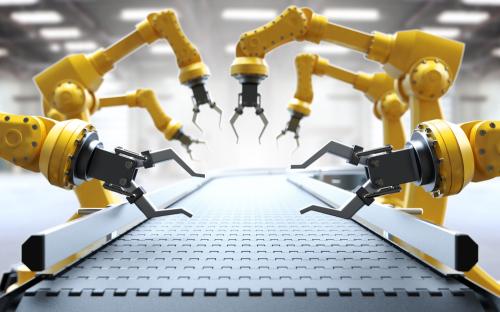The weakness of the economic recovery in advanced economies raises questions about the ability of new technologies to drive growth. After all, in the years since the global financial crisis, consumers in advanced economies have adopted new technologies such as mobile Internet services, and companies have invested in big data and cloud computing. More than 1 billion smartphones have been sold around the world, making it one of the most rapidly adopted technologies ever. Yet nations such as the United States that lead the world in technology adoption are seeing only middling GDP growth and continue to struggle with high unemployment.
There are many reasons for the restrained expansion, not least of which is the severity of the recession, which wiped out trillions of dollars of wealth and more than 7 million US jobs. Relatively weak consumer demand since the end of the recession in 2009 has restrained hiring and there are also structural issues at play, including a growing mismatch between the increasingly technical needs of employers and the skills available in the labor force. And technology itself plays a role: companies continue to invest in labor-saving technologies that reduce demand for less-skilled workers.
So are we witnessing a failure of technology? Our answer is “no.” Over the longer term, in fact, we see that technology continues to drive productivity and growth, a pattern that has been evident since the Industrial Revolution; steam power, mass-produced steel, and electricity drove successive waves of growth, which has continued into the 21st century with semiconductors and the Internet. Today, we see a dozen rapidly-evolving technology areas that have the potential for economic disruption as well in the next decade. They fall into four groups: IT and how we use it; machines that work for us; energy; and the building blocks of everything (next-gen genomics and synthetic biology).
Wide ranging impacts
These disruptive technologies not only have potential for economic impact—hundreds of billions per year and even trillions for the applications we have sized—but also are broad-based (affecting many people and industries) and have transformative effects: they can alter the status quo and create opportunities for new competitors.
While these technologies will contribute to productivity and growth, we must look at economic impact in a broader sense, which includes measures of surplus created and value shifted (for instance from producers to consumers, which has been a common result of Internet adoption). The greatest benefit we measured for autonomous vehicles—cars and trucks that can proceed from point A to point B with little or no human intervention. The largest economic impact we sized for autonomous vehicles is the enormous benefit to consumers that may be possible by reducing accidents caused by human error by 70 to 90 percent. That could translate into hundreds of billions a year in economic value by 2025.
Predicting how quickly even the most disruptive technologies will affect productivity is difficult. When the first commercial microprocessor appeared there was no such thing as a microcomputer—marketers at Intel thought traffic signal controllers might be a leading application for their chip. Today we see that social technologies, which have changed how people interact with friends and family and have provided new ways for marketers to connect with consumers, may have a much larger impact as a way to raise productivity in organizations by improving communication, knowledge-sharing, and collaboration.
There are also lags and displacements as new technologies are adopted and their effects on productivity are felt. Over the next decade, advances in robotics may make it possible to automate assembly jobs that require more dexterity than machines have provided or are assumed to be more economical to carry out with low-cost labor. Advances in artificial intelligence, big data, and user interfaces (e.g., computers that can interpret ordinary speech) make it possible to automate many knowledge worker tasks.
More good than bad
There are clearly challenges for societies and economies as disruptive technologies take hold, but the long-term effects, we believe, will continue to be higher productivity and growth across sectors and nations. In earlier work, for example, we looked at the relationship between productivity and employment, which are generally believed to be in conflict (i.e., when productivity rises, employment falls). And clearly, in the short term this can happen as employers find that they can substitute machinery for labor—especially if other innovations in the economy do not create demand for labor in other areas. However, if you look at the data for productivity and employment for longer periods—over decades, for example—you see that productivity and job growth do rise in tandem.
This does not mean that labor-saving technologies do not cause dislocations, but they also eventually create new opportunities. For example, the development of highly flexible and adaptable robots will require skilled workers on the shop floor who can program these machines and work out new routines as requirements change. And the same types of tools that can be used to automate knowledge worker tasks such as finding information can also be used to augment the powers of knowledge workers, potentially creating new types of jobs.
Over the next decade it will become clearer how these technologies will be used to raise productivity and growth. There will be surprises along the way—when mass-produced steel became practical in the 19th century nobody could predict how it would enable the automobile industry in the 20th. And there will be societal challenges that policy makers will need to address, for example by making sure that educational systems keep up with the demands of the new technologies.
For business leaders the emergence of disruptive technologies can open up great new possibilities and can also lead to new threats—disruptive technologies have a habit of creating new competitors and undermining old business models. Incumbents will want to ensure their organizations continue to look forward and think long-term. Leaders themselves will need to know how technologies work and see to it that tech- and IT-savvy employees are included in every function and every team. Businesses and other institutions will need new skill sets and cannot assume that the talent they need will be available in the labor market.
The Brookings Institution is committed to quality, independence, and impact.
We are supported by a diverse array of funders. In line with our values and policies, each Brookings publication represents the sole views of its author(s).







Commentary
Op-edWhy Isn’t Disruptive Technology Lifting Us Out of the Recession?
June 11, 2013